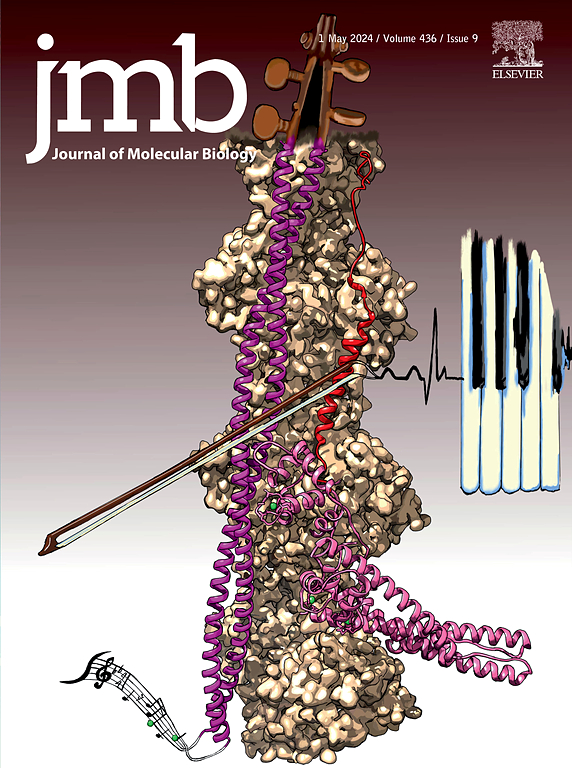Structural Basis of the LARP4-Filamin A Interaction and Competition with Integrin β7 Tails
IF 4.5
2区 生物学
Q1 BIOCHEMISTRY & MOLECULAR BIOLOGY
引用次数: 0
Abstract
Filamin A (FLNA) is an actin cross-linking protein that connects multiple transmembrane receptors and cytosolic signaling proteins to regulate cell shape, motility, and signaling. Our previous report has shown that FLNA interacts directly with the La-related protein 4 (LARP4) and this interaction is essential for cell migration. Here, using the x-ray crystallography and protein–protein interaction studies, we investigated the molecular basis of LARP4 binding to FLNA. We described the high-resolution structure of the FLNA immunoglobulin-like repeat 21 (R21) and its complex with the LARP4 peptide. The FLNA-binding site in LARP4 is localized between Ala269 and Asn281, where it forms an extended β strand that interacts with the cleft formed by β strands C and D of FLNA R21. Consistent with this structure, the A279Cfs*2 mutation found in catalogue of somatic mutations in cancer (COSMIC) database and the experimentally introduced F277A mutation both disrupt LARP4 binding to FLNA. In contrast, the COSMIC-listed N275S mutation alters LARP4 membrane localization without affecting FLNA interaction, suggesting distinct functional outcomes. Cell migration assays showed that LARP4-knockdown cells expressing FLNA-binding-deficient mutants migrated faster than those expressing wild-type LARP4. The LARP4-binding site on FLNA overlaps with the β-integrin tail-binding region, and in vitro assays revealed that LARP4 can compete with integrin β7 tails for FLNA R21 binding. These results suggest that the LARP4–FLNA interaction may regulate cell migration, at least in part, by competing with integrin tails, although this mechanism has yet to be confirmed in vivo.

LARP4-Filamin A与整合素β7 Tails相互作用和竞争的结构基础
丝蛋白A (FLNA)是一种肌动蛋白交联蛋白,连接多种跨膜受体和胞质信号蛋白,调节细胞形状、运动和信号传导。我们之前的报告表明,FLNA直接与la相关蛋白4 (LARP4)相互作用,这种相互作用对细胞迁移至关重要。本文利用x射线晶体学和蛋白-蛋白相互作用研究,研究了LARP4与FLNA结合的分子基础。我们描述了FLNA免疫球蛋白样重复21 (R21)及其与LARP4肽复合物的高分辨率结构。LARP4中的FLNA结合位点位于Ala269和Asn281之间,在那里它形成一个延伸的β链,与FLNA R21的β链C和D形成的裂缝相互作用。与这种结构相一致的是,在癌症体细胞突变目录(COSMIC)数据库中发现的A279C突变和实验引入的F277A突变都破坏了LARP4与FLNA的结合。相比之下,cosmic列表中的N275S突变改变了LARP4膜定位,但不影响FLNA相互作用,表明功能结果不同。细胞迁移实验显示,表达flna结合缺陷突变体的LARP4敲低细胞比表达野生型LARP4的细胞迁移速度更快。FLNA上的LARP4结合位点与β-整合素尾部结合区域重叠,体外实验显示LARP4可以与整合素β7尾部竞争FLNA R21的结合。这些结果表明,LARP4-FLNA相互作用可能通过与整合素尾部竞争来调节细胞迁移,至少在一定程度上是这样,尽管这种机制尚未在体内得到证实。
本文章由计算机程序翻译,如有差异,请以英文原文为准。
求助全文
约1分钟内获得全文
求助全文
来源期刊

Journal of Molecular Biology
生物-生化与分子生物学
CiteScore
11.30
自引率
1.80%
发文量
412
审稿时长
28 days
期刊介绍:
Journal of Molecular Biology (JMB) provides high quality, comprehensive and broad coverage in all areas of molecular biology. The journal publishes original scientific research papers that provide mechanistic and functional insights and report a significant advance to the field. The journal encourages the submission of multidisciplinary studies that use complementary experimental and computational approaches to address challenging biological questions.
Research areas include but are not limited to: Biomolecular interactions, signaling networks, systems biology; Cell cycle, cell growth, cell differentiation; Cell death, autophagy; Cell signaling and regulation; Chemical biology; Computational biology, in combination with experimental studies; DNA replication, repair, and recombination; Development, regenerative biology, mechanistic and functional studies of stem cells; Epigenetics, chromatin structure and function; Gene expression; Membrane processes, cell surface proteins and cell-cell interactions; Methodological advances, both experimental and theoretical, including databases; Microbiology, virology, and interactions with the host or environment; Microbiota mechanistic and functional studies; Nuclear organization; Post-translational modifications, proteomics; Processing and function of biologically important macromolecules and complexes; Molecular basis of disease; RNA processing, structure and functions of non-coding RNAs, transcription; Sorting, spatiotemporal organization, trafficking; Structural biology; Synthetic biology; Translation, protein folding, chaperones, protein degradation and quality control.
 求助内容:
求助内容: 应助结果提醒方式:
应助结果提醒方式:


